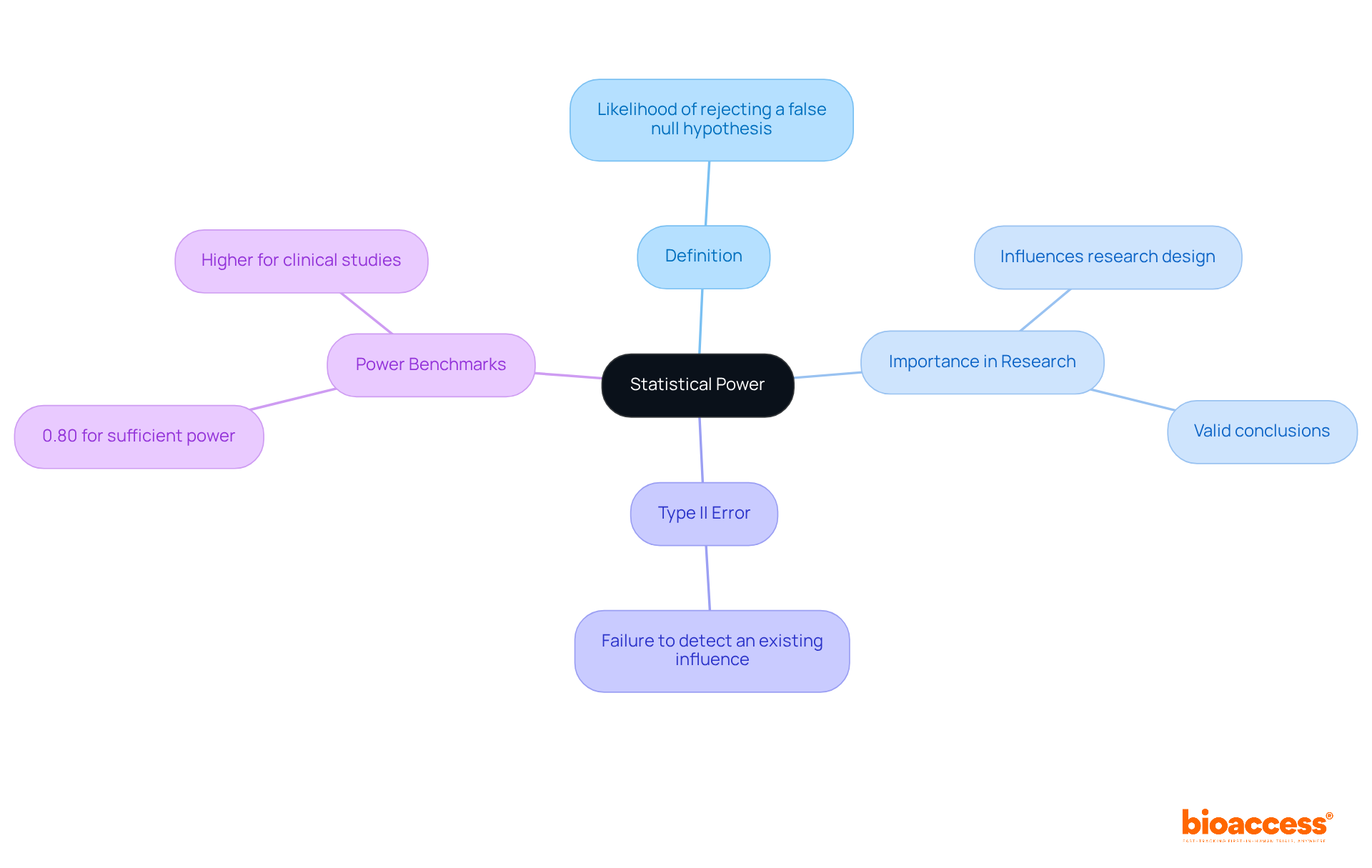


The concept of power in statistics signifies the probability that a statistical test will accurately reject a false null hypothesis, a fundamental aspect for drawing valid conclusions in research. Understanding and optimizing statistical power—typically aiming for a benchmark of 0.80—holds immense importance, as it can significantly diminish Type II errors and enhance the reliability of findings. This is particularly critical in clinical trials, where the precise detection of treatment effects is essential for patient care. By prioritizing statistical power, researchers can ensure that their studies yield credible and actionable insights.
Understanding statistical power is essential for researchers aiming to draw valid conclusions from their data. This concept, representing the likelihood of accurately rejecting a false null hypothesis, plays a critical role in clinical research, where the stakes can be life-altering. Alarmingly, many studies fall short of the necessary power, resulting in inconclusive findings that could misguide future research and policy.
What are the key factors influencing statistical power, and how can researchers ensure their studies are robust enough to detect genuine effects? Addressing these questions is crucial for enhancing the reliability of clinical research outcomes.
In statistics, power is represented by the likelihood that a statistical test will accurately reject a false null hypothesis. This concept is crucial in clinical research, as it assesses the probability of identifying a change when one exists. Mathematically, power is defined as 1 minus the likelihood of committing a Type II error (β). A Type II error occurs when a test fails to detect an existing influence.
A common benchmark for sufficient power is 0.80, indicating an 80% likelihood of identifying a change if it is present. This level of power is particularly significant in clinical settings, where the ability to recognize true effects can greatly impact patient outcomes. For instance, research in cancer therapy often requires higher power levels, sometimes exceeding 0.90, to ensure that significant differences are detected.
Understanding power in statistics is vital for researchers, as it directly influences research design and interpretation, ensuring that valid conclusions can be drawn from the data collected. By incorporating statistical analysis into the planning stages, researchers can optimize their study designs, allocate resources effectively, and ultimately enhance the reliability of their findings.

Statistical strength is crucial in effective research, especially in clinical trials, and understanding what does power mean in statistics is essential to recognizing its significance. A robust statistical capability significantly reduces the likelihood of Type II errors, illustrating what does power mean in statistics—instances where research fails to recognize a genuine influence. This is particularly vital in clinical settings, as neglecting an effective treatment can adversely affect patient care and lead to inefficient resource allocation.
For instance, studies with limited strength frequently yield inconclusive findings, potentially steering future research and policy decisions in the wrong direction. Recent evaluations indicate that only 15% of individual trials possess adequate capability to identify effect magnitudes akin to those observed in meta-analyses, underscoring a pervasive issue within clinical research.
To clarify what does power mean in statistics, achieving 80% effectiveness with a significance level of 0.05 necessitates a sample size of 100 participants per group, highlighting the critical relationship between sample size and statistical effectiveness. By ensuring that research is adequately powered, researchers not only bolster the reliability and credibility of their findings but also address what does power mean in statistics, making substantial contributions to the advancement of medical knowledge and improved patient outcomes.
Furthermore, the impact of study design on statistical strength is crucial; for example, Friedman et al. demonstrated that assessing cholesterol levels at both the beginning and conclusion of a clinical trial reduces variance and enhances statistical strength. Ultimately, prioritizing statistical strength is vital for fostering robust clinical evidence that informs effective healthcare practices.
As Jafar Farsani emphasizes, understanding what does power mean in statistics and the fundamental connections among statistical strength, sample quantity, and influence magnitude empowers researchers to make informed decisions in trial design.

Statistical strength, or what does power mean in statistics, plays a pivotal role in clinical research, influenced by several critical elements, including:
Larger sample sizes generally enhance effectiveness by providing a more comprehensive understanding of the population, thereby reducing sampling error. For instance, research requiring a minor impact magnitude of 0.2 necessitates a sample size of 788 to achieve adequate strength, while a greater impact magnitude of 2.5 only requires 8 participants. Notably, for an effect size of 1, with a strength of 0.8 and an alpha value of 0.05, the requisite sample size is 30. This highlights the significant influence of effect size on the ability to detect true effects; larger effect sizes are inherently easier to identify, thus bolstering statistical capability.
The significance level established by researchers is another crucial factor influencing effectiveness. The conventional significance level (alpha) is typically set at 5%. However, opting for a higher alpha level, such as 0.10, can enhance sensitivity, albeit at the cost of increasing the risk of Type I errors, where a true null hypothesis is mistakenly rejected. Furthermore, reduced variability within the data strengthens effectiveness, allowing for clearer distinctions between groups. For example, research focused on a specific demographic, such as female college graduates, can minimize variability in stress levels, thereby enhancing the strength of the statistical tests employed.
By understanding and refining these elements, researchers can design studies that are more likely to yield significant outcomes, ultimately enhancing the reliability and accuracy of their results in clinical research. As Pritha Bhandari notes, "What does power mean in statistics is primarily determined by sample volume, influence magnitude, and significance level." Moreover, the ideal power for research is generally considered to be 0.8 (80%), serving as a crucial benchmark in statistical analysis. Incorporating the Minimum Clinically Important Difference (MCID) as a method for assessing effect size can also yield valuable insights into the practical significance of study outcomes.

Understanding the concept of statistical power is essential for researchers aiming to draw valid conclusions from their studies. Power, defined as the probability of correctly rejecting a false null hypothesis, serves as a critical metric in determining the effectiveness of research designs, particularly in clinical settings. By grasping the implications of power, researchers can enhance their ability to detect meaningful changes and ultimately improve patient outcomes.
This article highlights key aspects of statistical power, including:
It underscores the importance of robust statistical strength in clinical trials, emphasizing that insufficient power can lead to erroneous conclusions that adversely affect healthcare decisions. By addressing these elements, researchers can ensure their studies are well-equipped to yield reliable and impactful findings.
Ultimately, prioritizing statistical power in research transcends mere academic exercise; it is a fundamental step towards advancing medical knowledge and enhancing patient care. Researchers are encouraged to integrate considerations of power into their study designs, ensuring that their work effectively contributes to the body of evidence guiding healthcare practices. By doing so, they not only uphold the integrity of their research but also play a vital role in fostering better health outcomes for all.
What is statistical power in research?
Statistical power is the likelihood that a statistical test will accurately reject a false null hypothesis. It assesses the probability of identifying a change when one exists.
How is statistical power mathematically defined?
Power is defined as 1 minus the likelihood of committing a Type II error (β), which occurs when a test fails to detect an existing influence.
What is a common benchmark for sufficient statistical power?
A common benchmark for sufficient power is 0.80, indicating an 80% likelihood of identifying a change if it is present.
Why is statistical power important in clinical research?
Statistical power is crucial in clinical research because it affects the ability to recognize true effects, which can greatly impact patient outcomes.
Are there specific fields that require higher levels of statistical power?
Yes, fields like cancer therapy often require higher power levels, sometimes exceeding 0.90, to ensure that significant differences are detected.
How does understanding statistical power influence research design?
Understanding power helps researchers optimize their study designs, allocate resources effectively, and enhance the reliability of their findings, ensuring valid conclusions can be drawn from the data collected.